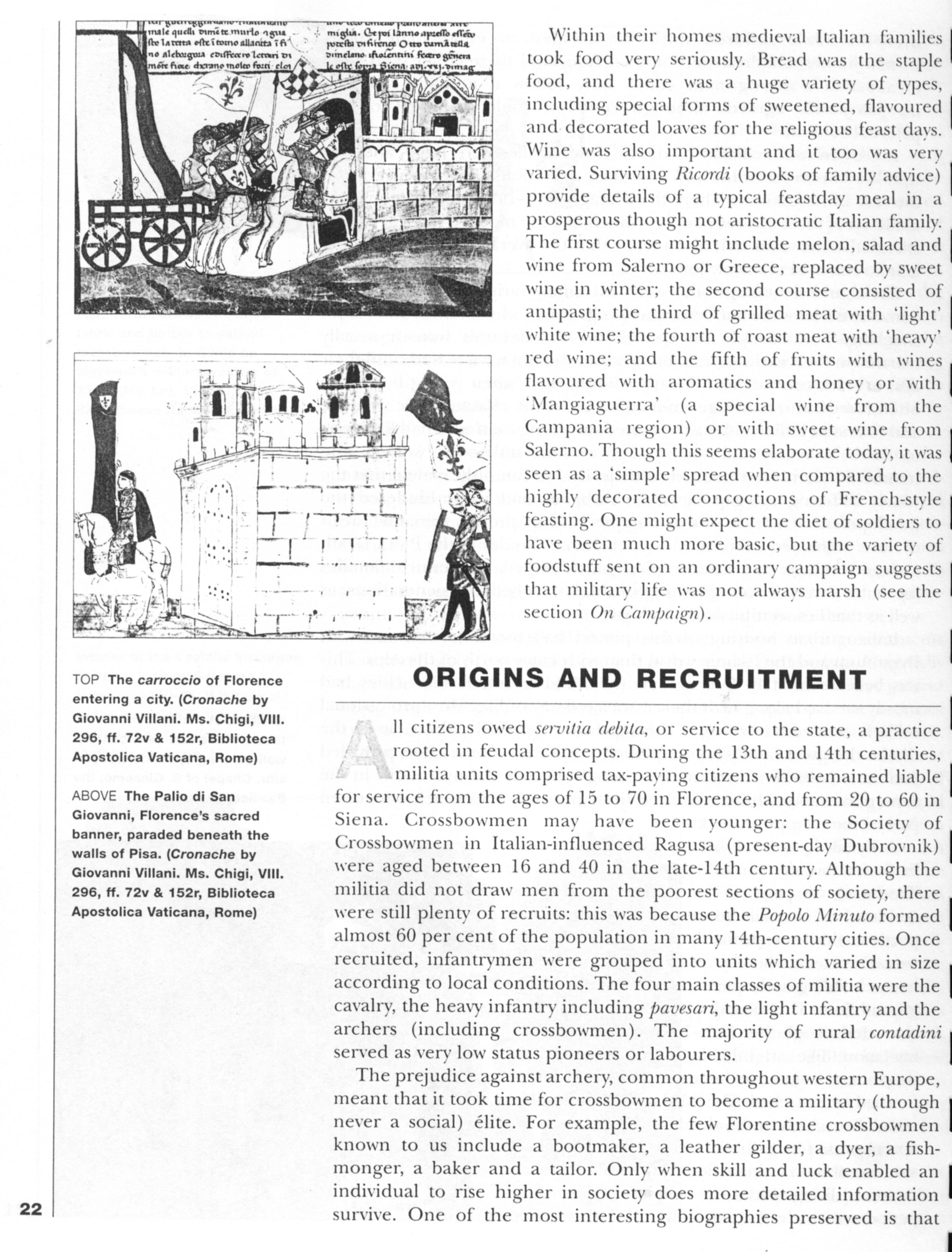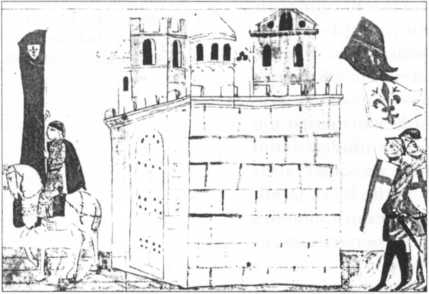39785 w25"

imalt qucfli rnmttt murlo -ryu*
|łVr lAtmii «4Vt i tomo aiiinrta 7 fi Ino iilrKugma ero Icttkri t> [mm finę Aowy moto fam etc
migtui. G*pn larmo.ipWTo r(Teń»
}vrrfta r*if\rcn« O m> tumiaflu dimrltno iftoiamnł faero ftrncra
;'vrrrT

TOP The carroccio of Florence entering a city. (Cronache by Giovanni Villani. Ms. Chigi, VIII. 296, ff. 72v & 152r, Biblioteca Apostolica Vaticana, Romę)
ABOVE The Palio di San Giovanni, Florence’s sacred banner, paraded beneath the walls of Pisa. (Cronache by Giovanni VII la ni. Ms. Chigi, VIII. 296, ff. 72v & 152r, Biblioteca Apostolica Vaticana, Romę)
Within their homes mediev.il Italian families took food very serionsly. Bread was the staple food, and there was a huge variety of types, including special forms of sweetened, flavoured and decorated loaves for the religious feast days. Winę was also important and it too was very varied. Surviving Ricordi (books of family advice) provide details of a typical feastday meal in a prosperous thongh not aristocratic Italian family. Tlie First course might inclnde melon, salad and winę from Salerno or Greece, replaced by sweet winę in winter; the second course consisted of antipasti; the third of grilled meat willi ‘light’ white winę; the fourth of roast meat with ‘heavy’ red winę; and the fifth of fruits with wines flavoured with aromatics and honey or with ‘Mangiaguerra’ (a special winę from the Campania region) or with sweet winę from Salerno. Thongh this seems elaborate today, it was seen as a ‘simple’ spread when compared to the highly decorated concoctions of French-style feasting. One might expect the diet of soldiers to have been much morę basie, but the variety of fooclstuff sent on an ordinary campaign suggests that military life was not alwavs harsh (see the section On Campaign).
ORIGINS AND RECRUITMENT ll citizens owed seruilia debila, or service to the State, a practice rooted in feudal concepts. During the I3th and 14th centuries, militia units comprised tax-paying citizens who remained liable for senice from the ages of 15 to 70 in Florence, and from 20 to 60 in Siena. Crossbowmen may have been younger: the Society of Crossbowmen in Italian-influenced Ragusa (present-day Dubrovnik) were aged between 16 and 40 in the late-14th century. Although the militia did not draw men from the poorest sections of society, there were still plenty of reeruits: this was because the Popolo Minuto formed almost 60 per cent of the population in many 14th-century cities. Once reeruited, infantrymen were grouped into units which varied in size according to local conditions. The four main classes of militia were the cavalry, the heavy infantry including pavesari, the light infantry and the archers (including crossbowmen). The majority of rural contadini sened as very Iow status pioneers or labourers.
The prejudice against archery, common throughout western Europę, meant that it took time for crossbowmen to become a military (though never a social) elite. For example, the few Florentine crossbowmen known to us include a bootmaker, a leather gilder, a dyer, a fish-monger, a baker and a tailor. Only when skill and luck enabled an individual to rise higher in society does morę detailed information survive. One of the most interesting biographies presened is that
22
Wyszukiwarka
Podobne podstrony:
skanowanie0011 (51) aW w aiHkx o fft-CfsW*. óif 3i
IMG!93 Ryu 11.18. Rozwiązanie przykładu 11.10 na wykresie /(/.n-X Ilość powietrza suchego potrzebna
Instrukcja do systemu tremolo2 Zakładanie strun w mostku typu Floyd Rosc rys. 6 ryu.7 rys. Ił rys 12
A.W25. różnicuje zakres obowiązków, odpowiedzialności i uprawnień zawodowych na poszczególnych
f « 366 SAINTB-ANNB DAURAY * de la fi£vre qui le travaillait depuis quelques heure
»«ts łvr<u (Vnwnv^
PUc C ćfKiM W*óok Z*H4CX Ryu* W,vm# Modyf4cv9 Ptr>^ł9^ Wo W**»« Bk* (*no Pomoc - &nbs
więcej podobnych podstron